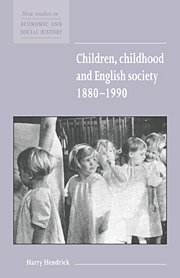Book contents
- Frontmatter
- Contents
- Acknowledgements
- 1 Introduction
- 2 New ideas of childhood: the 1880s to the 1920s
- 3 Parent–child relationships
- 4 Children and social policies
- 5 Children, schooling and the classroom
- 6 Children's leisure
- 7 Conclusion: disappearing childhood and children's rights
- Bibliography
- Index
- Titles available in the New Studies in Economic and Social History series
- Titles available in the Studies in Economic and Social History series
- Economic History Society
- Frontmatter
- Contents
- Acknowledgements
- 1 Introduction
- 2 New ideas of childhood: the 1880s to the 1920s
- 3 Parent–child relationships
- 4 Children and social policies
- 5 Children, schooling and the classroom
- 6 Children's leisure
- 7 Conclusion: disappearing childhood and children's rights
- Bibliography
- Index
- Titles available in the New Studies in Economic and Social History series
- Titles available in the Studies in Economic and Social History series
- Economic History Society
Summary
Setting the scene
My intention in this book is to provide readers with a reliable guide to the growing literature on the history of children and childhood over the period from 1880 to 1990. By children, I mean the age range from babyhood up to thirteen/fourteen years; the survey has little to say about adolescents – fourteen to eighteen year olds – except in passing. Over the last twenty years or so historians have come to accept the legitimacy of young people's history. This is not to say that a large number of monographs are devoted entirely to children for, as a quick glance at the bibliography will make clear, there are relatively few such volumes. Rather it is that scholars have begun to pay attention to the historical presence of children as part of their wider concerns with, for example, the family, social policy, maternal welfare, women, demography and public health. However, as the subject area has yet to become a major focus of research, either in terms of prestige or of popularity, there is not that surfeit of historical controversy which surrounds so many other topics in this series. Consequently, although due attention is paid to scholarly dispute where it exists, the emphasis in what follows will be on describing and interpreting the results of recent research.
The theme under review here is amorphous, its discourse lacks theoretical rigour, and it has no well-established historiographical tradition which could be used to structure the survey.
- Type
- Chapter
- Information
- Publisher: Cambridge University PressPrint publication year: 1997

